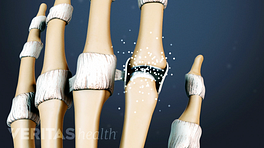Receiving a timely, accurate diagnosis for rheumatologic conditions in children can be challenging, because symptoms (e.g. pain) may initially be attributed to illness or injury—or the vague catch-all, “growing pains”. 1 What Is Juvenile Arthritis? Fast Facts: An Easy-to-Read Series of Publications for the Public. National Institute of Arthritis and Musculoskeletal and Skin Diseases. March 2009. Available at http://www.niams.nih.gov/Health_Info/Juv_Arthritis/juvenile_arthritis_ff.asp#4. Accessed December 2014. , 2 Bernstein S. Juvenile Arthritis: Early Signs and Symptoms. Arthritis Foundation: Kids Get Arthritis Too. Available at http://www.kidsgetarthritistoo.org/about-ja/juvenile-arthritis-early-signs-and-symptoms.php. Accessed December 2014.
Physicians, parents, and patients must be persistent. Receiving an accurate diagnosis is the first step toward beginning an appropriate and effective treatment plan.
In This Article:
- Juvenile Idiopathic Arthritis and Other Rheumatologic Diseases in Children
- Symptoms and Causes of Juvenile Rheumatologic Diseases
- Diagnosing and Treating Rheumatologic Conditions in Children
- Rheumatoid Arthritis Patient Story: Meet Sierra
Diagnosing Rheumatologic Conditions in Children
There is no single test to diagnose rheumatologic diseases in children. Moreover, the collection of symptoms experienced by children with these conditions can often make diagnosing the disease difficult and time consuming.
The first step toward receiving an accurate diagnosis is consulting a pediatric rheumatologist. The pediatric rheumatologist will take a complete medical history, ask about symptoms, conduct a physical exam, and conduct several tests, including but not limited to:
- Blood tests, including complete blood counts, and inflammation markers such as ESR and CRP
- X-ray, MRI, and/or bone scan
- Tests for viruses or bacteria, such as Lyme disease
- Joint aspiration for synovial fluid tests
See Lyme Disease and Rheumatoid Arthritis (RA) vs. Fibromyalgia
The results of these tests will help rule out other conditions and define the specific type of rheumatologic disease the child may have.
Treating Juvenile Arthritis and Inflammatory Conditions
Just as there is no one test for diagnosing rheumatologic diseases in children, there is no one treatment. Instead, an individualized treatment plan to addresses a patient’s specific condition and needs.
The individualized treatment plan is designed by a team lead by the pediatric rheumatologist. This team may include a rheumatologist, physical and occupational therapists, dentist, and others.
See Other Specialists for Arthritis Treatment
Timely diagnosis and treatment on rheumatologic conditions in children is important for minimizing their impact and increasing the patient’s quality of life. In general, treatment plans for these conditions address the following broad issues:
Control of inflammation and pain. Anti-inflammatory medications may be prescribed to help reduce pain and swelling caused by inflammation, which can limit joints’ range of motion. A child’s doctor may prescribe medication to address pain and inflammation, such as NSAIDs, analgesics, and corticosteroids. There may be additional, non-medical therapies available to certain patients, including:
- massage therapy
- dietary supplements
- acupuncture
- relaxation techniques, such as meditation
As always, when undertaking a new supplemental treatment, the patient’s physician(s) should be consulted.
Movement. Keeping kids with arthritis moving is important. Once acute pain is controlled, exercise is recommended to maintain range of motion and joint function. Physical therapy is a very important part of the treatment. Depending on the extent of joint involvement, children may need to be excused from activities and gym classes during a flare of arthritis.
In addition to medications prescribed for pain relief and control of inflammation, disease-modifying antirheumatic drugs (DMARDs), or a subset of DMARDs called biologics, may be prescribed. These drugs are typically prescribed after other options have failed to provide adequate relief.
There is no cure for juvenile arthritis, but an appropriate treatment plan can help patients effectively manage their symptoms and prevent damage to joints.
- 1 What Is Juvenile Arthritis? Fast Facts: An Easy-to-Read Series of Publications for the Public. National Institute of Arthritis and Musculoskeletal and Skin Diseases. March 2009. Available at http://www.niams.nih.gov/Health_Info/Juv_Arthritis/juvenile_arthritis_ff.asp#4. Accessed December 2014.
- 2 Bernstein S. Juvenile Arthritis: Early Signs and Symptoms. Arthritis Foundation: Kids Get Arthritis Too. Available at http://www.kidsgetarthritistoo.org/about-ja/juvenile-arthritis-early-signs-and-symptoms.php. Accessed December 2014.










